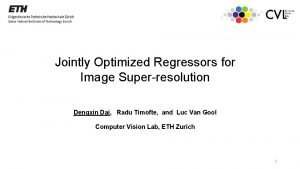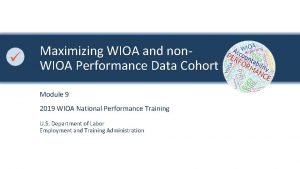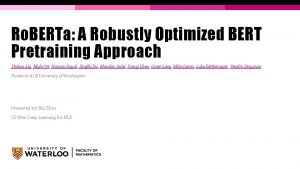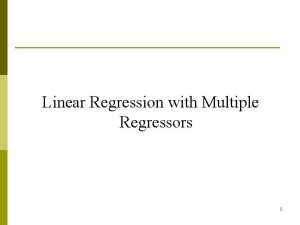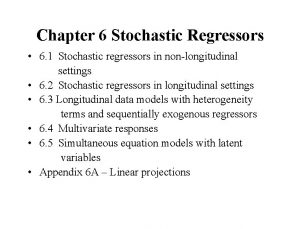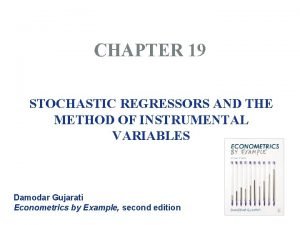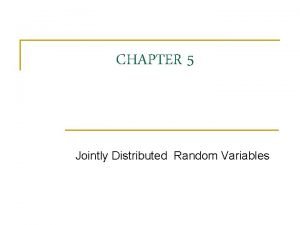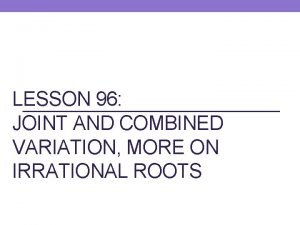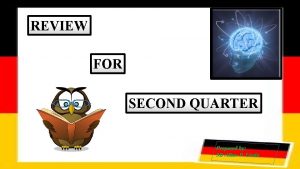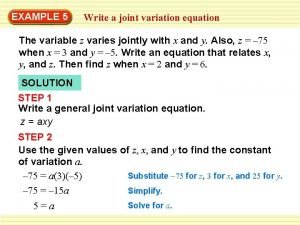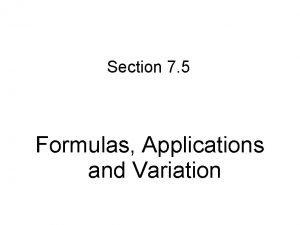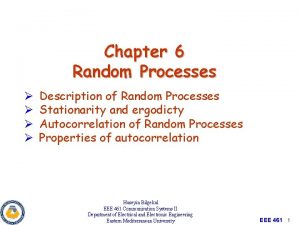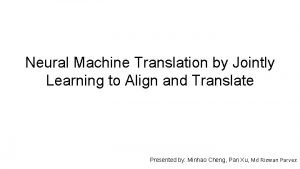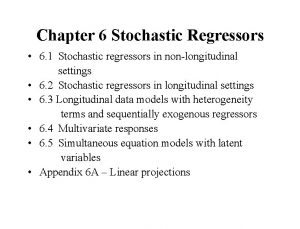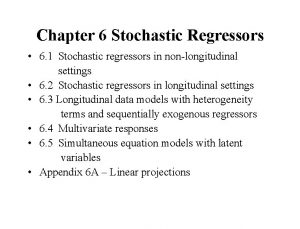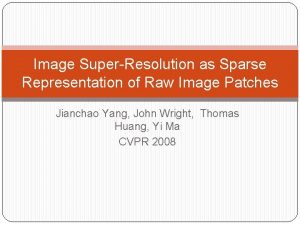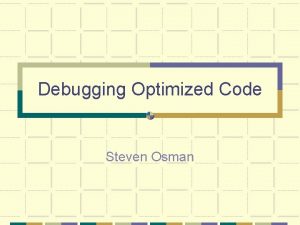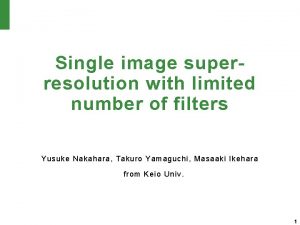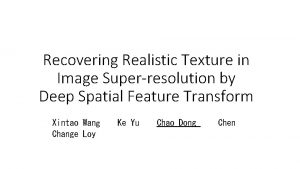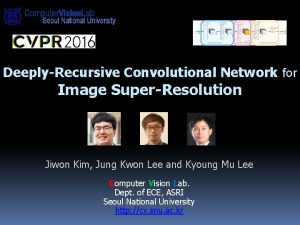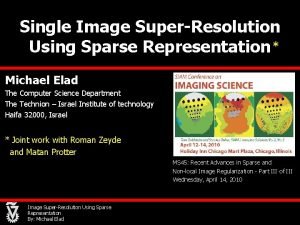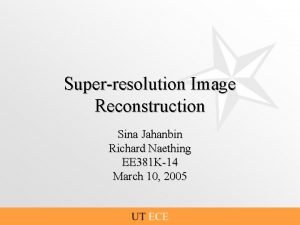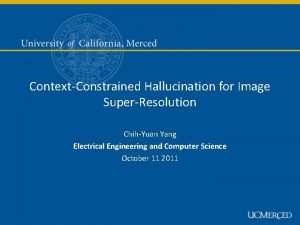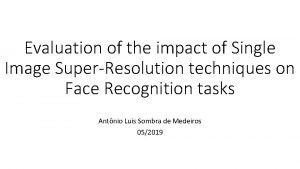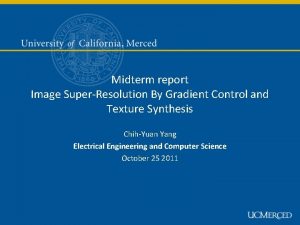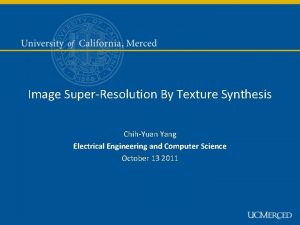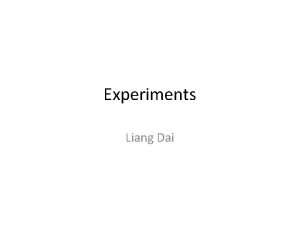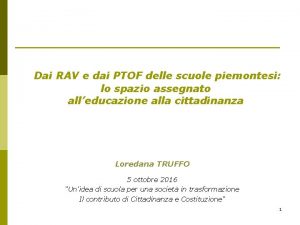Jointly Optimized Regressors for Image Superresolution Dengxin Dai
































- Slides: 32

Jointly Optimized Regressors for Image Super-resolution Dengxin Dai, Radu Timofte, and Luc Van Gool Computer Vision Lab, ETH Zurich 1

The Super-resolution Problem Noise Blur and Decimation + ≈ Interpolate: align Super-resolution: coordinates content Recoverhigh-freq. the HR image from the LR one 2

Why Image Super-resolution? (1) For good visual quality This kitten made out of legos? They aren’t cuddly at all! This kitten is adorable! I want to adopt her and give her a good home! Image source: http: //info. universalprinting. com/blog/ 3

Why Image Super-resolution? (2) Pre-processing component for other computer vision systems, such as recognition • Features & models are often trained with images of normal resolution Low-resolution Super-resolution result 4

Example-based approaches Core part: learning Training examples Input Output Highly ill-posed problem Ground truth Not available during testing 5

Core idea – patch enhancement Learning transformation function for small patches 1. Less complex, tractable 2. Better chance to find similar patterns from exemplars Interp. Patch enhance & average Input Output 6

Training data Training pairs (easy to create) … … HR images Matching patch-pairs … LR images Feature Extraction (LR) Learning Feature Extraction (HR) 7

Training the Dictionaries – General Feature extraction (HR) HR LR High-Freq. Interpolate Down-sample Patch Size: 6 x 6, 9 x 9 or 12 x 12 8

Training the Dictionaries – General Feature extraction (LR) HR LR 1 1 0 0 1 0 -1 -1 -2 1 0 -2 0 1 0 Gradient 1 Laplacian Interpolate Down-sample Patch Size: 6 x 6, 9 x 9 or 12 x 12 9

Training the Dictionaries – General Learning methods The transformation from LR patches to HR ones: Related Work: • k. NN + Markov random field [Freeman et al. 00] • Neighbor embedding [Chang et al. 04] • Support vector regression [Ni et al. 07] • Deep neural network [Dong et al. 14] Non-parametric Computationally heavy A highly non-linear function Complex optimization • Simple functions [Yang & Yang 13] • Anchored neighborhood regression [Timofte et al. 13] A set of local (linear) functions Efficient, but regressors learned separately 10

Training the Dictionaries – General Differences to related approaches Methods Simple functions [Yang & Yang 13] and ANR [Timofte et al. 13] Ours Goal Partition space Regressors # of regressors A set of local regressors LR patches Learned separately 1024 (typical) A set of local regressors Regression functions Learned jointly 32 (typical) 11

Training the Dictionaries – General Our approach – Jointly Optimized Regressors Learning: a set of local regressors, collectively yield smallest error for all training pairs • Individually precise • Mutually complementary Testing: each patch is super-resolved by its most suitable regressor, voted by nearest neighbors Regressor 1 Regressor 2 … Regressor O input output 12

Training the Dictionaries – General Our approach – learning Two iterative steps (similar to k-means): • Update step: learn repressors to minimize the SR error of all pairs of each cluster • Assignment step: assign each pair to the regressor yielding the least SR error Initialization: separate matching pairs into O clusters … … … HR … LR … Cluster 2 … … Cluster 1 Cluster O 13

Training the Dictionaries – General Our approach – learning Update step: learn a regressor per group by minimizing the SR error Ridge Regression: … … LR … … HR … … Regressor 1 Regressor 2 Regressor O 14

Training the Dictionaries – General Our approach – learning Assign. step: assign each pair to the regressor yielding the least SR error … … HR LR … … Cluster 3, Regressor 3 Cluster 2 Regressor 2 SR error Update step … Cluster 1, Regressor 1 Assign. step Until convergence (~10 iterations) Re 1 Re 2 Re 3 Re 4 Re 5 15

Training the Dictionaries – General Our approach – learning 5 million patches HR … LR SR error After iterations, each LR patch is associated with a vector indicating the SR error by each of the O regressors kd-Tree [Vedaldi and Fulkerson 08] 16

Training the Dictionaries – General Our approach – testing LR filtering search k. NN LR vote SR error interpolate Similar patches share regressors Re 1 Re 2 Re 3 Re 4 Re 5 input Kd-Tree Regressors 17

Training the Dictionaries – General Our approach – testing LR High-Freq. Average = Regressor 3 Ridge Regression interpolate input output 18

Results • Compared with 7 competing methods on 4 datasets (1 newly collected) • Our method, yet simple, outperforms others consistently Average PSNR (d. B) on Set 5, Set 14, BD 100, and Super. Tex 136 19

PSNR (d. B) Results The number of iterations • Better results with more iterations The number of regressors • Better results with more regressors 20

PSNR (d. B) Results The number of training patches • Better results with more training patch pairs 21

Ground truth / PSNR Factor x 3 22

Bicubic / 27. 9 d. B Factor x 3 23

Zeyde et al. /28. 7 d. B Factor x 3 24

SRCNN /29. 0 d. B Factor x 3 25

JOR /29. 3 d. B Factor x 3 26

Results: factor x 4 Ground truth / PSNR SRCNN/ 31. 4 d. B JOR / 32. 3 d. B 27

Results: factor x 4 Ground truth / PSNR Bicubic / 32. 8 d. B JOR / 33. 7 d. B 28

Results: factor x 4 Ground truth / PSNR Bicubic / 25. 5 d. B Zeyde et al. / 26. 7 d. B Bicubic ANR/ 26. 9 d. B SRCNN / 27. 1 d. B JOR / 27. 7 d. B 29

Conclusion • A new method by jointly optimizing regressors with the ultimate goal of ISR • The method, yet simple, outperforms competing methods • The code is available at www. vision. ee. ethz. ch/~daid/JOR • A new dataset, 136 textures evaluating texture recovery ability 30

Ground truth / PSNR Bicubic / 31. 2 d. B SRCNN / 33. 3 d. B JOR / 34. 0 d. B Thanks for your attention! Questions? 31

Reference Dai, D. , R. Timofte, and L. Van Gool. "Jointly optimized regressors for image superresolution. " In Eurographics, 2015.
 Dengxin dai
Dengxin dai Wioa optimized system
Wioa optimized system Roberta: a robustly optimized bert pretraining approach
Roberta: a robustly optimized bert pretraining approach Multicollinearity
Multicollinearity Stochastic regressors
Stochastic regressors Stochastic regressors
Stochastic regressors Joint probability distribution function
Joint probability distribution function Joint and combined variation
Joint and combined variation The current i varies directly as the electromotive force
The current i varies directly as the electromotive force Joint proportion examples
Joint proportion examples The drag force f on a boat varies jointly
The drag force f on a boat varies jointly Random process
Random process Bleu
Bleu Frgar
Frgar Karttecken ruin
Karttecken ruin Fimbrietratt
Fimbrietratt Matte större än tecken
Matte större än tecken Delegerande ledarstil
Delegerande ledarstil Elektronik för barn
Elektronik för barn Särskild löneskatt för pensionskostnader
Särskild löneskatt för pensionskostnader Blomman för dagen drog
Blomman för dagen drog Borra hål för knoppar
Borra hål för knoppar Mat för unga idrottare
Mat för unga idrottare Bris för vuxna
Bris för vuxna Argument för teckenspråk som minoritetsspråk
Argument för teckenspråk som minoritetsspråk Etik och ledarskap etisk kod för chefer
Etik och ledarskap etisk kod för chefer Indikation för kejsarsnitt på moderns önskan
Indikation för kejsarsnitt på moderns önskan Datorkunskap för nybörjare
Datorkunskap för nybörjare Steg för steg rita
Steg för steg rita Fspos vägledning för kontinuitetshantering
Fspos vägledning för kontinuitetshantering Ekologiskt fotavtryck
Ekologiskt fotavtryck Redogör för vad psykologi är
Redogör för vad psykologi är Ministerstyre för och nackdelar
Ministerstyre för och nackdelar
